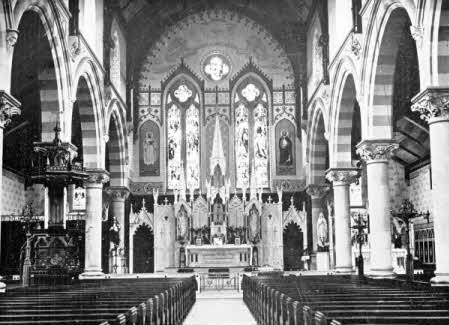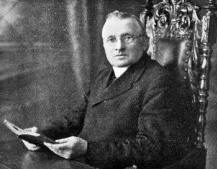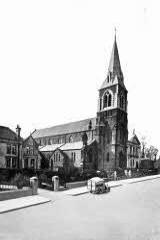St. Patrick's Church History
THE NEW PARISH CHURCH

Interior of St. Patrick's Church, Lisburn
(photo by the Northern Whig and
Belfast Post, Belfast)
 The
present Pastor, Very Rev. Canon O'Boyle, entered his labours at a
time when Lisburn was practically deserted by Catholics after the
burnings of 1920, when the parochial house was destroyed and the
Catholic business people and many of the workers (to the number of
1300) had left. He, assisted by his loyal flock, which has now Very
Rev. J. Canon O'Boyle, P.P., V.F. St. Patrick's, Lisburn assumed in
numbers and influence a position not inferior to what they held in
1920, has done; many useful and costly works in ecclesiastical
construction since he came to the parish.
The
present Pastor, Very Rev. Canon O'Boyle, entered his labours at a
time when Lisburn was practically deserted by Catholics after the
burnings of 1920, when the parochial house was destroyed and the
Catholic business people and many of the workers (to the number of
1300) had left. He, assisted by his loyal flock, which has now Very
Rev. J. Canon O'Boyle, P.P., V.F. St. Patrick's, Lisburn assumed in
numbers and influence a position not inferior to what they held in
1920, has done; many useful and costly works in ecclesiastical
construction since he came to the parish.
The splendid Gothic Church of St. Patrick, on Chapel Hill, erected by his predecessor at a cost of £13,000, is undoubtedly one of the landmarks of old Lisnagarvey, and is admired by visitors as a very imposing, commodious, and handsome church.
 St. Patrick's Church was dedicated on 10th June, 1900. The old
church had long been unsuited to the growing needs of the parish.
It had served the needs of a time when stately edifices were few and
far between, and when people were compelled to be content with
humble provision for Divine Worship. With the dawn of the new
century better and brighter times had come for the faithful, and the
completion of the new church evoked great joy amongst the
parishioners.
St. Patrick's Church was dedicated on 10th June, 1900. The old
church had long been unsuited to the growing needs of the parish.
It had served the needs of a time when stately edifices were few and
far between, and when people were compelled to be content with
humble provision for Divine Worship. With the dawn of the new
century better and brighter times had come for the faithful, and the
completion of the new church evoked great joy amongst the
parishioners.
St. Patrick's Church remained with the tower incomplete from 1900 till 1932. The present Parish Priest, Canon O'Boyle, with the wholehearted support of his parishioners, set himself to the task of adding the spire to the unfinished tower. The result is eloquent of the success achieved. St. Patrick's has now its crowning glory, which adds not alone to the church but to the entire town.
When, from a distance, one looks at the imposing structure outlined against the sky, the noise of traffic unheard, and the imagination alert, one is swept back across the vista of centuries to the Middle Ages, when men were not wholly absorbed in mundane things, when the sameness of the landscape was diversified by church and steeple, convent and monastery. The spire, which tapers gracefully, is octagonal in shape, and rests on a square base. There are three strata of Yorkshire stone, one at the base of the spire, one at the centre, and one higher up, meant to be symbolic of the Trinity.
One solid stone, five hundredweight at the apex, acts as a base for the richly gold ornamented nine and a half feet cross that towers above the one hundred and fifty-five feet spire.
The mellow-toned bell, which for years rested on wooden props at the back of the church, is now worthily housed in the graceful tower, with its four Gothic windows, which emit the` sound for miles across town and country.
Truly a work of art, flawless in every detail, this magnificent structure is an eloquent tribute to the zeal and piety of the Pastor and his people.
